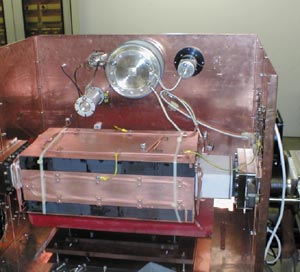After the venerable Cooler Ring at the Indiana University Cyclotron Facility (IUCF) passed on to accelerator heaven in autumn 2002, the polarized beam team, led by Alan Krisch, crossed the Atlantic to continue their spin-manipulation work at COSY, the cooler synchrotron at the Forschungszentrum in Jülich (figure 1). As part of the SPIN@COSY collaboration, they have been improving the polarization capabilities of the 3.5 GeV/c proton and deuteron storage ring.
Recently, the collaboration – from Michigan and Brookhaven in America, COSY, Bonn and Hamburg in Germany, and KEK and J-PARC in Japan – has used a new ferrite RF-dipole magnet to flip the spins of stored 2.1 GeV/c protons with almost no polarization loss.

The ferrite-core water-cooled RF-dipole (figure 2) was designed and built by Maria Leonova, a graduate student at Michigan, and Alexander Schnase, a COSY/J-PARC electrical engineer. It was coupled to a sophisticated RF high-voltage supply to form a highly tuned L-C circuit, which produced a transverse RF magnetic-field integral of about 1.5 Tmm peak-to-peak.

This gave a higher spin flip efficiency (99.92 ± 0.04%) than the air-core RF-dipole used for the spin-flipping of polarized deuterons and protons during SPIN@COSY’s first runs in February and April 2003. The total polarization loss was only about 3% after 51 spin flips (figure 3), which allows many spin-flips of polarized proton or electron beams while they are stored for billions of turns.

This spin-flipping would greatly reduce almost all systematic errors in spin asymmetry experiments, which is very important for scattering experiments in storage rings with stored polarized beams, such as Brookhaven’s Relativistic Heavy Ion Collider (RHIC), HERA at DESY, COSY and the MIT-Bates facility in Massachusetts.
Combining an earlier IUCF spin-flipping experiment at 489 MeV/c with this higher-energy 2.1 GeV/c experiment at COSY leads to a “prediction” that a slightly stronger RF-dipole magnet – only about 35% stronger than the small RF dipole used already – should give at least the same 99.92% spin-flip efficiency to the polarized protons stored in the 100-250 GeV RHIC and perhaps someday in Japan’s 50 GeV J-PARC facility and CERN’s 7 TeV Large Hadron Collider. This is because the spin-flipping strength of a transverse RF-dipole is almost invariant under the Lorentz transformation from an accelerator’s stationary frame to the highly relativistic rest frame of each beam proton, where each proton’s spin observes the RF-dipole’s strength, which controls the efficiency of the spin-flips.
Further reading
M A Leonova et al. 2004 Phys. Rev. Lett. 93 224801.
V S Morozov et al. 2004 Phys. Rev. ST-Accel. Beams 7 024002.







